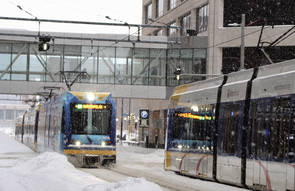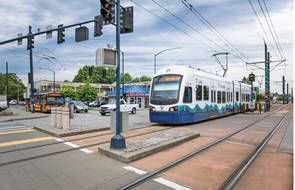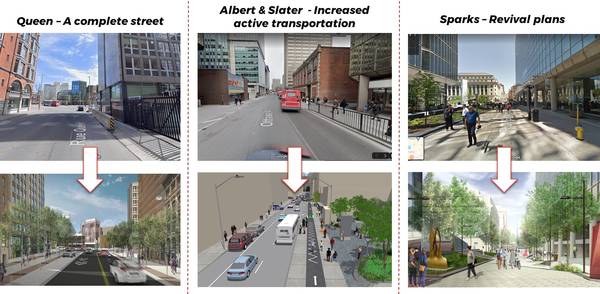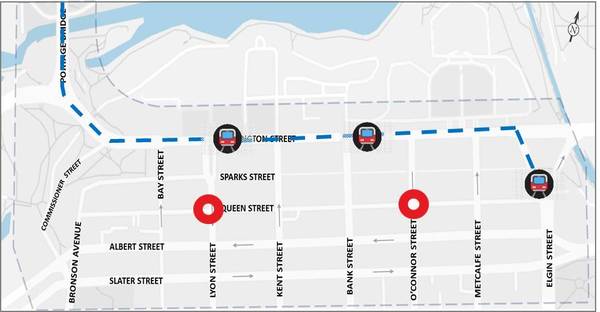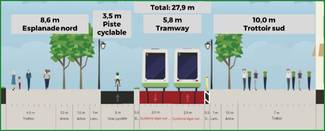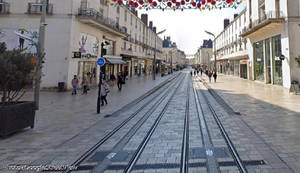DEDICATED PUBLIC TRANSIT SYSTEM BETWEEN GATINEAU'S WEST END AND THE DOWNTOWNS OF GATINEAU AND OTTAWA
The public consultation on the options to integrate this dedicated public transit system into Ottawa has ended. View the report highlights here.

Would you like to find out more about what impact will COVID-19 have on public transit needs? Click here! |
|---|
The Société de transport de l'Outaouais (STO) is currently undertaking the Additional Study for a structuring Public Transit System in Gatineau's West End in order to improve the Gatineau transit network between Gatineau's west end and the downtowns of Gatineau and Ottawa. This project will also improve the connectivity between Gatineau and Ottawa. As part of this study the STO has held a public consultations to give both Gatineau and Ottawa residents a chance to comment on the options for integrating this dedicated public transit system in the downtown of Ottawa that are currently under study. As a reminder, a public consultation was held in June 2019, it enabled citizens to express their opinion, in particular on the scenarios on the Gatineau side.
Note that this project is not a master transportation plan for the two cities and it does not preclude other potential interprovincial connectivity improvements.
- Context and Needs
- Transportation Modes
- Crossing of the Ottawa River
- Rationale for Tram Component
- Components of the Transit Connection on the Ottawa side
- Options for Integrating the Tram Component into Ottawa
- Pros and Cons
- Traffic Studies
- Evaluation of Each Scenario
- Participating in the consultation - NOW ENDED
- Questions and answers
The following elements are part of the Complementary Study that is currently underway, and that these may change to some extent, either as a result of the current study or in subsequent phases of the overall project. These elements are presented with the objective of gathering comments from residents of the metropolitan area.
Context and Need
Over the past several years, Gatineau's population has grown significantly, particularly in its west end.
The demand for public transit services between Ottawa and Gatineau is increasing, as does automobile traffic. The roads have been at capacity during peak periods for years, and current public transit services to downtown Gatineau and Ottawa will not be able to meet the needs of the growing population by 2051.
In order to meet this need, the STO is studying the potential for a dedicated public transit system that will effectively link the west of the city of Gatineau to the downtowns of Gatineau and Ottawa.
This study is being undertaken in consultation with the following municipal, provincial and federal stakeholders:
- Ministère des Transports du Québec;
- National Capital Commission;
- City of Gatineau;
- City of Ottawa.
The dedicated public transit system is important from a metropolitan point of view for both Ottawa and Gatineau. There are approximately 200,000 trips every day between the two cities (approximately 25% of which are on public transit). The following video provides a quick overview of this project.
The introduction of a dedicated public transit system would attract more users to public transit than the STO's current public transit system. This would:
- significantly increase public transit ridership between Gatineau and Ottawa;
- curtail congestion in downtown Gatineau by reducing automobile traffic;
- curtail congestion in downtown Ottawa by reducing automobile growth traffic and the number of STO buses.
Studies show that congestion both on the Gatineau and the Ottawa sides will only get worse without a dedicated public transit system from Gatineau. The demand to commute to Ottawa continues to rise and this must be addressed through transit rather than privately-owned vehicles.
Picture on the left: Credit - JULIE OLIVER / Postmedia
Transportation Modes
Characteristics of the transportation modes being considered
The study assessed different transportation modes. Only options that include either a tram or bus rapid transit (BRT) were deemed appropriate in view of the project's needs and constraints.
Bus Rapid Transit (BRT)
- A BRT is primarily a transit project with bus technology which can operate as follows :
- implementation of a new dedicated transit corridor or reserved lanes on existing roadway corridors and separate stations; and
- a dedicated transit system with feeder routes or accessible to all routes.
- In some cases, it has an urban revitalization component
- The average speed of a BRT on either dedicated corridor would be approx. 30km/h
- Different possible types of vehicles (standard or articulated buses)
- Priority at intersections
- BRT capacity:
- regular bus: 55 passengers
- articulated bus: 90 passengers
- bi-articulated bus: 125 to 150 passengers
Picture on the left: BRT - Nîmes, Frances. Picture on the right: BRT - Bogota, Colombie.
Tram
- A tram is electrified rail transit technology that operates generally in an urban setting, with features such as:
- generally level crossing at intersections;
- full redesign/reconstruction of underground utilities and roadway infrastructure that would have to be relocated;
- quality urban design, generally complete makeover of the transit corridors;
- dedicated transportation system;
- standard electrical power supply through catenary wiring, but may also run on batteries at specific points (Portage Bridge, downtown Ottawa).
- Average operating speed in urban areas: 20 km/h.
- Possible operating speed in less densely developed areas, with stations located farther apart: 25 km/h.
- Need for a dedicated garage close to the route.
- Priority at intersections.
- Tram capacity: 260 to 375 passengers.
Picture on the left: Tram - Minneapolis, USA. Picture on the right: Tramway - Seattle, USA.
To learn more about… |
|---|
Crossing of the Ottawa River
For the interprovincial link, the dedicated transit system would have to cross the Ottawa River. The 6 bridges connecting Gatineau and Ottawa were assessed based on the projected destinations of Gatineau riders. The Portage Bridge has been selected as the preferred link between the two cities,. The following video provides an overview of this assessment.
Rationale for Tram Component
Connecting to the Ottawa transit system is essential to the success of the new dedicated public transit system. Therefore, the STO and the projects key stakeholders are reviewing detailed analyses of the options in Ottawa. Listen to the following video for additional information about this aspect.
This detailed analysis revealed that when it comes to moving transit riders efficiently between Gatineau and Ottawa, buses are not enough. Due to the maximum capacity offered by this transportation mode only a scenario with at least one tram component will be viable to meet both medium and long term needs.
Components of the Transit Connection on the Ottawa side
The following video describes the main characteristics of the proposed transit connection in Ottawa, including the need to maintain a certain number of STO bus routes along with the tram component (regardless of which transit scenario in Western Gatineau is ultimately selected).
One of the main advantages of the dedicated system is its ability to move a large number of users with fewer public transit vehicles, which reduces the number of STO buses in downtowns of Gatineau and Ottawa.
Depending on the scenario, the number of STO buses in downtown Ottawa would be reduced by 30 % to 70 %.
Options for Integrating the Tram Component into Ottawa
Main Design Considerations
Potential corridors in downtown Ottawa were assessed based on a number of considerations, including:
System requirements
- Straightest possible route for a tram.
- Efficient connection with the O-Train stations.
- Attractive system for riders (reliable, stops close to places of interest).
- One way in each direction.
Importance and prestige of the Confederation Boulevard
City of Ottawa development plans
- Queen Street redesigned as a complete street to accommodate more pedestrians.
- Sparks Street rejuvenation plans.
- Albert and Slater repurposed to include active transportation.
- Various cycling projects, including on Bay and Wellington streets.
The studies conducted, including the above considerations, identified two main options for integrating the tram component:
- surface integration on Wellington Street;
- tunnel integration under Sparks Street.
Each of these options are described further below.
Number of Tram Stations in Downtown Ottawa
Regardless of which corridor is selected, the number of trams stations and their locations are critical to the efficiency of the proposed connection in Ottawa. The following video presents the different aspects that have been taken into consideration to determine the number of stations required, as well as the main conclusions.
Surface Integration on Wellington Street Option
Description of the Integration Option
- Arrival by the Portage Bridge without overhead catenary wires.
- At-grade integration on Wellington Street without overhead catenary wires.
- Route continuing along Wellington Street until Elgin Street, in dedicated transit lanes.
Wellington Street has been identified as the preferred corridor for an at-grade integration of the tram. Two scenarios for this corridor were developed:
- where traffic is maintained along the entire length of Wellington Street; and
- where vehicular traffic is eliminated between Bank Street and Elgin Street.
Although for each of these options, three tram stations would best meet the needs and objectives of the overall project, the many compromises necessary to fit each of them along this corridor is one aspect of this study that is still under review.
The design of a tram on Wellington Street would have to be in line with the needs, functions and esthetics of Confederation Boulevard, including its function as a ceremonial route and its symbolic role as a place of national interest. This could involve specific features, such as minimal infrastructure or running the tram on batteries instead of overhead catenary wires.
Route and Proposed Tram Station Locations
- Distributing transit riders over 3 stations would allow for :
- many customers to walk directly to their downtown destination without having to transfer to the O-Train, thereby reducing travel times;
- more comfortable waiting, boarding and disembarking conditions (i.e. less crowding at each station).
- The following proposed locations would meet the needs of the project, but these would be refined during the next phases of the overall project where more detailed analysis of various aspects such as the built environment or the functional and security constraints of the areas would be undertaken.
- Lyon / Wellington station;
- Bank / Wellington station;
- Elgin / Queen terminus station.
- Due to the very large anticipated volume of pedestrians coming from the first tram station that would be required to cross Wellington Street ( either transfer to the O-Train at Lyon Station or to walk directly to a downtown destination), a pedestrian tunnel could be added to facilitate this movement. It would include a direct connection between these two stations. As with the different components of the project, this tunnel would be designed in compliance with the various applicable standards and regulations, including the most stringent safety requirements.
- Transfer time between the tram on Wellington and the O-Train Lyon and Parliament stations is estimated to be approximately 5 minutes (3 minutes walking and 2 minutes waiting at signalized intersections).
Impacts of the Integration Option
- Full redesign and reconstruction of the Wellington Street corridor to integrate the tram and the bike lane planned by the City of Ottawa and the NCC, while conserving a wide space for pedestrians in accordance with the standards for Confederation Boulevard.
- The stations would be designed to fit in with the layouts of Wellington Street and Elgin Street.
- Some STO buses would continue to cross over to Ottawa (in mixed traffic), using one of three loops, depending on the bus routes.
Two Possible Scenarios
Two possible scenarios are under review for the Wellington corridor.
The stations would be arranged in a minimalist style. An example of an existing tram station with traffic and high pedestrian density is the Place de la Bourse station in Bordeaux, France.

To learn more about… |
|---|
Constraints related to access to Parliament Hill
There are currently 8 access points to and from Parliament Hill on the north side of Wellington Street. In order to integrate the tram on Wellington Street while remaining as much as possible within the available right-of-way, these accesses will have to be further studied in depth in order to confirm the layouts that will ensure efficient traffic circulation to and within Parliament Hill. It should be noted that integrating a tram on Wellington Street will likely significantly impact many of these accesses in order for the tram to run efficiently and safely. This impact to the Parliamentary accesses may be deemed too significant for the functions of Parliament Hill which could affect the feasibility of this option.

Tunnel Integration Under Sparks Street Option

Description of the Integration Option
- Arrival by the Portage Bridge.
- Crossing the open space west of Commissioner Street.
- Integration into the tunnel in the vicinity of Commissioner Street.
- The route runs parallel to that of the O-Train, but under Sparks Street instead of under Queen Street.
Sparks Street has been identified as the preferred corridor for a tunnel integration of the tram.
Route and Proposed Tram Station Locations
- The stations would be positioned to facilitate transfers with the O-Train:
- Lyon/Sparks station; and
- O'Connor/Sparks terminal station.
- These proposed locations would meet the needs of the project, but these would be refined during the next phases of the overall project where more detailed analysis of various aspects such as the built environment or the nature of the soils and its geotechnical characteristics would be undertaken.
- The tunnel can be brought close to Elgin Street, but it would be difficult to have a station in the vicinity of O'Connor Street and another in the vicinity of Elgin Street because they would be too close to each other for efficient transit operation.
- Pedestrians could choose the quickest route out of the tunnel to their destination, including direct underground connections to the O-Train stations which would provide weather protected transfers. Exits would be strategically located to optimize access to users' final destinations.
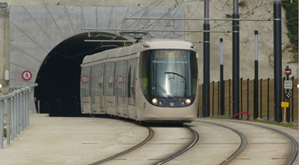
Impacts of the Integration Option
- Redesign and reconstruction of the area next to the open space west of Commissioner Street.
- Some STO buses would continue to cross over to Ottawa on surface, in mixed traffic.
- Very low impact on the urban layout, no impact on Wellington Street.
To learn more about… |
|---|
Pros and Cons
Surface Integration on Wellington Street
Pros
- Ground level stations make it easier to access.
- Easier to construct.
- Could be used as a component of a potential future interprovincial loop with the Alexandra Bridge, although there will be significant technical issues to address at the Wellington-Mackenzie and Wellington-Sussex intersections.
Cons
- Corridor has several uses competing for space:
- north esplanade width standards;
- partial widening of the south sidewalk;
- planned two-way bike facility;
- vehicular traffic lanes.
- Some compromises will be required on this corridor to also include a tram.
- Security concerns around the Parliamentary and Judicial Precincts and at stations.
- Possible transit service disruptions due to demonstrations and other special events on Wellington Street (alternative arrangements is required to ensure service continuity).
- Disruption to current traffic and transit service during construction (will require detour planning and traffic management).
- Pedestrian safety concerns as option will lead to a significant increase in the number of pedestrians crossing Wellington to reach the stations.
Tunnel Integration Under Sparks Street
Pros
- Light impact on traffic and surface amenities.
- Allows for more direct connection with the O-Train.
- Weather protected environment for transferring passengers.
- Less vulnerable to service interruptions from external events such as demonstrations.
Cons
- Higher cost than surface option.
- Complex and lengthier construction with higher risks.
- Significant underground constraints (utilities and foundations of adjacent buildings).
- Portal will significantly impact the open space west of Commissioner Street.
- Possible security concerns of adjacent federal institutions.
Traffic studies
The various integration options would have different impacts on traffic in downtown Ottawa. The two scenarios with a tram on Wellington Street involve a reconfiguration of the existing traffic lanes, and would therefore see traffic redistributed to other streets.
Traffic studies, are currently being carried out to measure the impacts of the proposed modifications. The integration of a tram would attract more users to public transit and therefore reduce the number of vehicles coming to downtown Ottawa, which in turn limits the traffic pressure exerted on several other corridors in the city center, as compared to not having a tram. Thus, traffic analyzes show that, in general, each scenario with a tram would improve future traffic conditions compared to the status quo.
To learn more about… |
|---|
Evaluation of Each Scenario
The performance of each integration option has been compared to a scenario described as “Status quo”, which represents the situation in the year 2031 without a tram from Gatineau. This comparison allows for further evaluation of each option. The main characteristics of the status quo and integration options are as follows:
Status quo 2031
- No new dedicated transit system. The STO bus service will continue to operate strictly with buses, as it currently does.
- + Least expensive scenario because no tram system would be built.
- - Least effective scenario for public transit from the point of view of operations, ridership and customer experience.
- - Least effective scenario for pedestrians because of high vehicle traffic volumes.
- - With no improvement, the overall public transit system will not attract many new users. Many people will continue using their car, which will have a negative impact on traffic.
Scenario 1 ” Surface integration on Wellington Street, with traffic”
- Tram with 3 stations.
- + Trams attract new users to public transit with the promise of comfortable vehicles, a reliable system, and a good overall experience.
- + Very efficient scenario for traffic.
- - Certain compromises will be needed, particularly in terms of the stations, in order to provide wide sidewalks, a two-way bike lane, the tram and vehicle traffic lanes along Wellington Street.
- - The space of the bike facility in the vicinity of the proposed Parliament tram Station is limited, which requires compromises for its layout.
Scenario 2 ” Surface integration on Wellington Street, without traffic”
- Tram with 3 stations.
- + Trams attract new users to public transit with the promise of comfortable vehicles, a reliable system, and a good overall experience
- + Pedestrians have more space between Bank Street and Elgin Street.
- - The scenario with the most impacts on vehicular traffic, especially with the elimination of vehicular access between Bank Street and Elgin Street.
Scenario 3 ”Tunnel integration under Sparks Street”
- Tram with 2 stations.
- + Trams attract new users to public transit with the promise of comfortable vehicles, a reliable system, and a good overall experience.
- + The most effective scenario for public transit with no impact on Wellington Street.
- + Very efficient scenario for traffic and vehicles accessibility.
- - The most expensive scenario due to the construction of the tunnel.
In brief, the status-quo would not be viable in the long term. In order to ensure efficient transportation in light of the projected population increase, a reliable and efficient public transit system is needed.
The 3 tram scenarios would deliver efficient transportation, each with advantages and drawbacks.
Participating in the consultation
The public consultation has now ended. The deadline date for submission of comments was July 19, 2020. See the results.
If you have questions, you can contact us at etudedelouest@sto.ca. Questions received will be summarized with answers provided in the Q&A section (which will be regularly updated).







